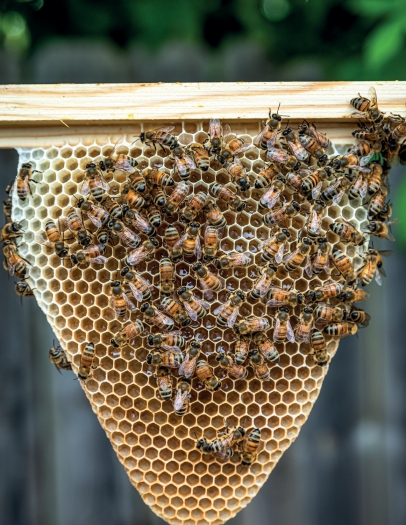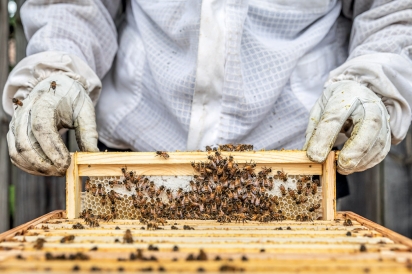Giving Bees a Chance
Brad Gladstone readily admits what almost seems unthinkable: He once was afraid of bees.
“I would run pretty fast in the other direction if one was around,” he says. “I was under the conventional mind-set that bees were these aggressive creatures.”
Today Gladstone owns Urban Bee, a full-service bee stewardship program with 20 hives at 13 metro-Detroit locations. A CPA by day, Gladstone started the Commerce-based biodynamic bee business in 2017 to not only share his passion, but to help change any negative narrative about bees, particularly in more urban settings, where “even today it’s still a little taboo,” he says.
“There’s so much to appreciate because if you like to eat, you kind of need bees.”
Practitioners of biodynamics eschew the notion of “keeping” or “having” bees. Instead, the goal is to steward bees by providing a clean environment that supports their healthy existence and let nature be in control. Gladstone doesn’t accept clients who spray pesticides in their yard or garden.
“Biodynamics methodology views each colony as a whole, just like a human,” says Gladstone, who studied virtually through Spikenard Honeybee Sanctuary in Floyd, Virginia. “It drives home the point that the whole hive is a living organism.”
That’s why Gladstone names the hives.
“Naming the hives and looking at them through the lens of biodynamics, I remember them individually. It’s just more natural to what’s going on,” he says, adding that having an outside entity pull the roof off your house every week would be troubling, to say the least. Instead, Gladstone reads indicators—takes its pulse—to get a sense of the hive’s wellness and whether he needs to add or swap out a frame. “If they’re healthy and they’re doing well I won’t even touch it.”
It’s all part of the biodynamic mindset, says Gladstone, explaining that it’s about grounding yourself and recognizing what’s in front of you, including that bees have their own emotions and thought processes, so be present and respectful.
“It’s a more natural, hands-off approach,” says Gladstone, adding that biodynamic practitioners open a hive only when they have a purpose. “So once we go in, once we achieve our purpose, we close it up.”
This is the third summer Ann Delisi has had a hive.
“It’s an endless fascination to me,” she says.
The WDET radio host and producer met Gladstone through James Rigato, chef and owner of Mabel Gray in Hazel Park. Both have sung Urban Bee’s praises on the air. Delisi even planted a pollinator garden during the pandemic, filling it with mountain mint, lavender, bee balm and anise hyssop, among a whole host of other plants.
“People ask, ‘Why didn’t you cut it back?’ I let everything flower because that’s what the bees want,” says Delisi, whose husband, Chris Staels, mows the lawn a little less frequently now too. “Our lawn has been taken over by the clover, which is great for the bees. We’re just kind of thoughtful about what’s going to work for this little ecosystem over here. It’s an adventure.”
Gladstone installed Delisi’s hive Joya in May 2019. A second hive, Journey, came just five weeks later. Both swarmed this summer—on the same day, but some 50 miles apart because Journey was at Gladstone’s— so he gave them a respite as they repopulate their modified Warre hive, named for the early-20th-century French abbot Emile Warre. Chris Harvey of Teakwood Organics in Grand Traverse County builds the sustainable red cedar hive boxes.
Even as Gladstone gently disassembles the hive’s roof and insulation box, bees busily continue their jobs, moving in and out of the entrance. Gladstone points out a drone bee and explains that it basically acts as the hive’s nervous system, connecting the colony to a regional aviary within a three-mile radius.
Each member of a colony plays a role. Worker bees forage, clean, nurse or act as undertaker, among other jobs. Older bees—drones and worker bees can live 4-6 weeks or 4-6 months, depending upon the season—do the most dangerous jobs, like collecting water.
“They’re kind of a living, breathing internet for a colony,” says Gladstone of the worker bees, who share information, such as possible locations for a new home, communicating by way of what’s called a waggle dance. “It’s them passing on GPS coordinates, essentially.”
Queen bees can live up to six years and only leave for mating flights, rejuvenation flights or to swarm, says Gladstone, adding that her job is to lay roughly 2,500 eggs daily at summer’s peak. Gladstone can see that Journey has the all-important egg cells: “You can see they’re healthy.”
The bees all have interconnected roles with each other, so if you mess with one part you mess with all of it, he says: “You’re dealing with an entity. You aren’t just dealing with a box with a bunch of bees.”
For Gladstone, the honey is secondary to stewarding the bees. The honey—and its immune-boosting propolis, thought to have antiviral and anti-inflammatory properties and other benefits—is a byproduct.
Unless the hive becomes honey-bound, so filled with honey the bees lack space to brood, Gladstone waits until springtime to harvest any excess honey, increasing the likelihood that the bees will have plenty to safely survive the winter. In a picture-perfect spring, he’ll harvest 80 percent of the honey, leaving the rest to continue to feed the bees. About a week later he returns the frames and all the honey to the client.
“I’m trying to promote healthy colonies over honey production,” says Gladstone. “I just want healthy bees, rather than just getting honey.”
Delisi appreciates that approach.
“Our goal wasn’t to get honey. Our goal was to advance the bee population. Getting honey is a lovely byproduct of doing that,” says Delisi, whose hives produced three pounds of honey for the first time this spring. “We weren’t in it for the honey, but it’s great when we get it.”
“I feel really grateful,” says Delisi, whose double lot feels like an oasis. “I’ve just wanted to make it more beautiful and make Detroit a little bit better. I just hope that our little contribution makes a difference, doing our thing for the environment and the world.”
Bees have always sparked James Rigato’s curiosity, because of how their work so intrinsically goes hand-in-hand with gardening and farming: “Being a chef, I’m probably a more captive audience than most people.”
Gladstone initially installed the hive Mabel on Rigato’s Mabel Gray rooftop in 2018. Having it at the restaurant was cool, says Rigato, until he realized that the bees were unlikely to survive a harsh Michigan winter there. Gladstone relocated it to Rigato’s diversely planted full-scale urban garden with raised beds, perennials and fruit trees. The almost-half-acre triple lot is, essentially, a little farm, says Rigato.
“Watching the bees thrive and the garden thrive—watching that relationship—honestly, I get more and more out of it every day,” says Rigato, calling it mind-blowing. “Every day my love of bees grows and Brad curates that. He’s an invaluable resource for me.”
Rigato calls Urban Bee an incredible bargain for the knowledge Gladstone imparts as curator, educator and bee steward. One hive generally runs about $2,000—$3,000. For that cost, Gladstone prepares and nurtures the new Warre box and is basically on call for support in addition to his regular visits. He also winterizes the hives and harvests the honey.
“I try to keep it simple. I just do the flat rate and it’s annually. It’s like anything else, like snow removal,” says Gladstone, adding that he probably visits a client 20—30 times a year.
The honey harvested from Rigato’s hives has appeared in several Mabel Gray specials and most recently in a variation of the Bee’s Knees cocktail.
“Bee’s Knees is a great way to stretch the life, to get multiple people to consume that honey,” says Rigato, who revels in the nuance, texture and smokiness of his own harvested honey. “It’s like drinking a high-quality home brew vs. Coors Light.”
Like Delisi, Rigato’s experience is so much more than the sweet taste of honey. It’s about doing what they feel is right for the planet. Stewarding the bees and hosting his August vegan month is his way of “exploring the ethics of this industry,” says Rigato. This microcosm serves a bigger vision of trying to repair his tiny little corner of the world, he says.
“I feel more bonded with the earth. We’re all connected. You can either care about it or not,” says Rigato. “How much longer can we consume everything in sight before the ocean’s on fire and the bees are gone? It’s all connected. Brad is just one little piece of the puzzle, but once you start collecting the pieces it starts getting exciting.”
Learn more at urbanbeellc.com.






